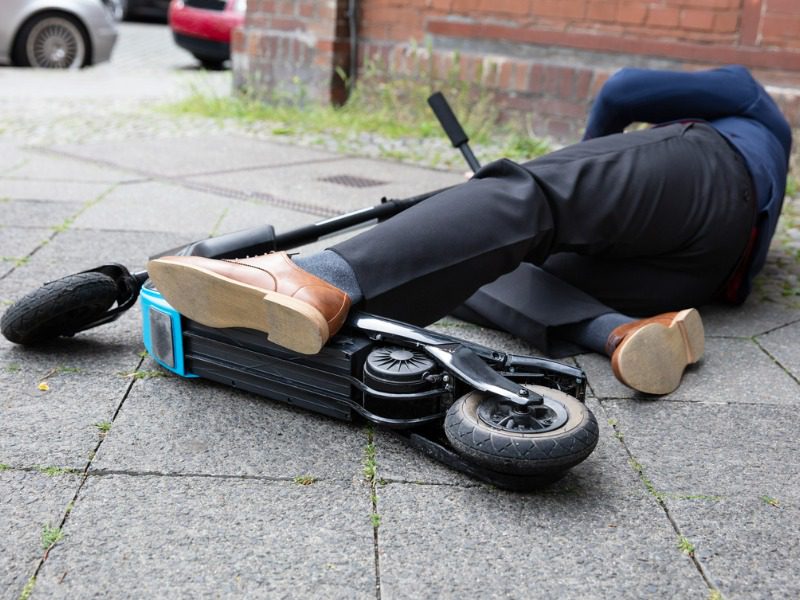How potholes lead to serious brain injuries for e-scooter riders

Editor’s note: This is the second of a two-part series on the biomechanics of rider falls from e-scooters. Part 1 appeared Aug. 25.
Road safety is directly linked to maintenance standards.
In Ottawa, the city’s recommended maintenance quality standard applies to bridges, and paved and treated road surfaces that include cycling lanes, and paved and gravel shoulders. It also defines the treatment for surface distortions that could pose risks to cyclists and motorists.
This standard allows surface distortions, like potholes, to be up to 25 centimetres wide and 5 centimetres deep on roadways, and up to 40 centimetres wide and 8 centimetres deep on paved or non-paved shoulders.
Based on that, e-scooter riders might encounter surface variations on roadways that can cause inattentive or inexperienced users to fall.
Recent computer modelling shows that, at 10 kilometres per hour, a falling e-scooter rider’s head impacted the ground at an average speed of 4.8 metres per second. And at 20 kilometres per hour the head impacted the ground at an average 6.9 metres per second.
To assess the risk of injury associated with these impacts, the Head Injury Criterion (HIC), a measurement that quantifies the severity of a head impact by incorporating its magnitude and duration, can be calculated and compared to risk curves for severe brain injuries.
The Abbreviated Injury Scale (AIS), which is used to classify and describe the severity of injuries, is coded from 1 to 6. On that scale, 1 is a minor injury such as a scrape or a headache, and 6 is a maximal injury that is not treatable.
An injury rated as an AIS 4-plus is severe and can be life-threatening or cause long-term problems. The classification can include penetrating skull injuries that lead to brain injury, large contusions and subdural, subarachnoid, and intracerebral hematomas (in other words, depressed skull fractures and brain bleeds).
So, an AIS 4-plus is a severe type of head injury that can cause significant damage to the brain.
Protecting riders
There is an estimated 50% risk of fracture for an adult skull at a peak head acceleration of approximately 260 g-forces, with head accelerations greater than 500 g-forces resulting in a higher than 99% risk of fracture for an adult skull.
Based on the HIC results, it is also noteworthy that the probability of an AIS 4-plus brain injury was determined to be 99.9% for an un-helmeted head impact speed of 5.4 meters per second. That’s a likely head impact speed for e-scooter riders travelling between 10 and 20 kilometers an hour.
When wearing a helmet, these head accelerations dropped to a g-force of between 154 and 181. Wearing a helmet reduced the probability of a severe brain injury (AIS 4-plus) to 9.3% for a 5.4 metres per second impact speed and 30.6% for a 6.3 metres per second impact speed.
Other research showed head impact speeds of 5.4 metres per second and 6.3 metres per second — which is within the range obtained in the scooter study — resulted in peak head accelerations of 601 to 824 g-forces when not wearing a helmet.
The head acceleration levels discussed earlier can also be compared to the acceleration levels associated with concussion in the peer-reviewed literature.
Based on their findings, a rider who’s thrown from their e-scooter while not wearing a helmet will likely sustain a head exposure that is approximately 6 times to 8.4 times greater than the threshold associated with medically diagnosed concussions.
By contrast, helmeted riders would sustain a head exposure that is approximately 1.6 times to 1.8 times greater. So, a helmet will likely prevent serious skull and brain injuries but may not eliminate the risk of a concussion.
While helmets are not required for riders who are 18 years of age or older, the data shows they should be encouraged for everyone.
Brittany Sinclair, B.Sc., P.Eng. is an associate in the Biomechanics & Personal Injury Group at 30 Forensic Engineering.
Feature image courtesy of iStock.com/AndreyPopov






